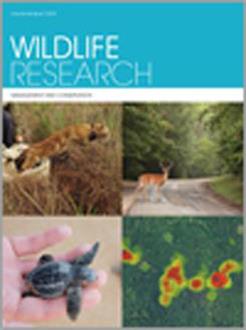Context. Visual encounter surveying is a standard animal inventory method, modifications of which (e.g. distance sampling and repeated count surveys) are used for modelling population density. However, a variety of factors may bias visual survey counts.
Aims. The aim of the present study was to evaluate three observer-related biases: (1) whether fatigue compromises detection rate as a survey occasion progresses; (2) whether long-term fatigue or boredom compromise detection rates over the course of a survey period; and (3) whether observers exhibit biases in detection rates of different animal taxa.
Methods. We analysed >2.3 × 104 observations of lizards and small mammals from nocturnal pedestrian visual encounter surveys, each 4 h in duration, conducted by a pool of 29 observers, each of whom surveyed for up to 31 nights.
Key results. Detections of sleeping (diurnal) emerald tree skinks (Lamprolepis smaragdina) exhibited a small but statistically verified decline as the evening progressed, whereas detections of sleeping (diurnal) green anoles (Anolis carolinensis) increased as the evening progressed. Detections of nocturnal geckos (several species pooled) showed a weak and non-significant declining trend. Small mammal sightings (rats, shrews and mice pooled) declined strongly over the course of an evening. The participants saw greater or equal numbers of animals the more nights they surveyed. Most participants exhibited statistically significant, and often strong, taxonomic detection bias compared with the pool of peer observers. The skills of some observers appeared to be consistently above average; others consistently below average.
Conclusions. Data on sleeping lizards suggest that neither short-term nor long-term observer fatigue is of much concern for 4-h visual searches. On the contrary, differences among observers in taxonomic bias and overall detection skills pose a problem for data interpretation.
Implications. By comparing temporal detection patterns of immobile (e.g. sleeping) with actively moving animal taxa, sampling biases attributable to searcher fatigue versus the animals’ circadian rhythm can be disentangled and, if need be, statistically corrected for. Observer skill differences and observer-specific taxonomic biases may hamper efforts to statistically evaluate survey results, unless explicitly included as covariates in population models.






